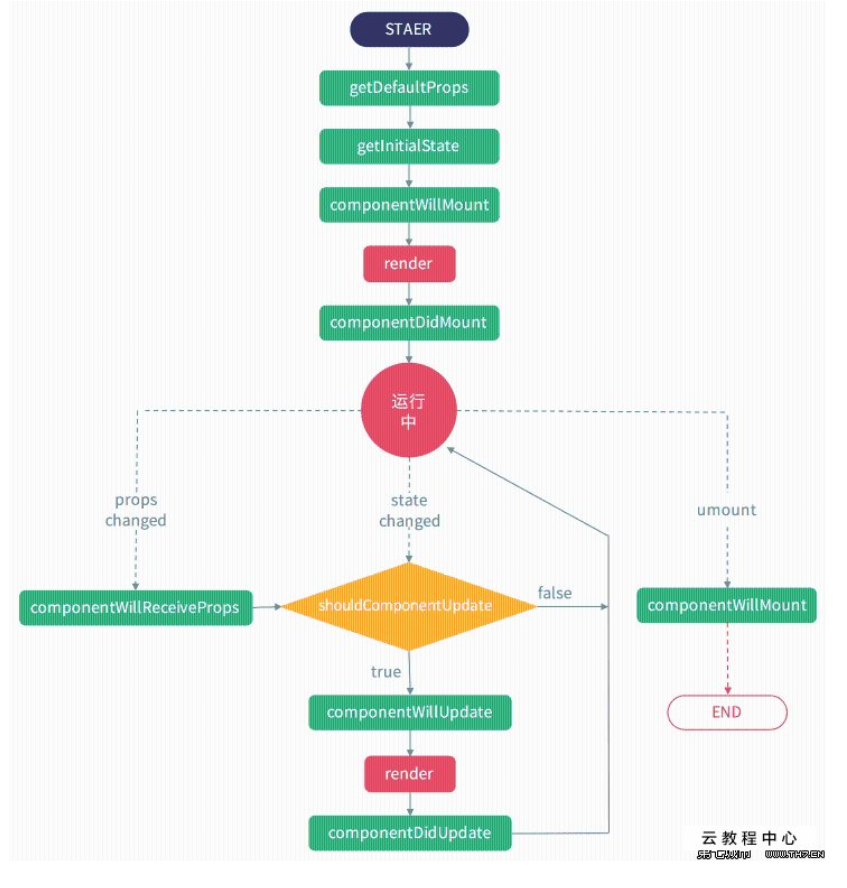前言
学习React,生命周期很重要,我们了解完生命周期的各个组件,对写高性能组件会有很大的帮助。
React生命周期
React生命周期分为三种状态
1.初始化阶段(getDefautProps getInitIalState componentWillMount render componentDidMount)
2.运行阶段(shouldComponentUpdate componentWillReceiveProps componentWillUpdate render componentDidUpdate)
3.销毁阶段(componentWillMount)
 、
、
实例化
首次实例化
- getDefaultProps
- getInitialState
- componentWillMount
- render
- componentDidMount
实例化完成后的更新
- getInitialState
- componentWillMount
- render
- componentDidMount
存在期
组件已存在时的状态改变
- componentWillReceiveProps
- shouldComponentUpdate
- componentWillUpdate
- render
- componentDidUpdate
销毁&清理期
- componentWillUnmount
说明
生命周期共提供了10个不同的API。
1.getDefaultProps
作用于组件类,只调用一次,返回对象用于设置默认的props,对于引用值,会在实例中共享。
2.getInitialState
作用于组件的实例,在实例创建时调用一次,用于初始化每个实例的state,此时可以访问this.props。
3.componentWillMount
在完成首次渲染之前调用,此时仍可以修改组件的state。
4.render
必选的方法,创建虚拟DOM,该方法具有特殊的规则:
- 只能通过
this.props和this.state访问数据 - 可以返回
null、false或任何React组件 - 只能出现一个顶级组件(不能返回数组)
- 不能改变组件的状态
- 不能修改DOM的输出
5.componentDidMount
真实的DOM被渲染出来后调用,在该方法中可通过this.getDOMNode()访问到真实的DOM元素。此时已可以使用其他类库来操作这个DOM。
在服务端中,该方法不会被调用。
6.componentWillReceiveProps
组件接收到新的props时调用,并将其作为参数nextProps使用,此时可以更改组件props及state。
componentWillReceiveProps: function(nextProps) {
if (nextProps.bool) {
this.setState({
bool: true
});
}
}
7.shouldComponentUpdate(nextProps,nextState)
react 性能优化非常重要的一环。组件接受新的state或者props时调用,我们可以设置在此对比前后两个props和state是否相同,如果相同则返回false阻止更新,因为相同的属性状态一定会生成相同的dom树,这样就不需要创造新的dom树和旧的dom树进行diff算法对比,节省大量性能,尤其是在DOM结构复杂的时候。
8.componentWillUpdate
接收到新的props或者state后,进行渲染之前调用,此时不允许更新props或state。
9.componentDidUpdate
完成渲染新的props或者state后调用,此时可以访问到新的DOM元素。
10.componentWillUnmount
组件被移除之前被调用,可以用于做一些清理工作,在componentDidMount方法中添加的所有任务都需要在该方法中撤销,比如创建的定时器或添加的事件监听器。